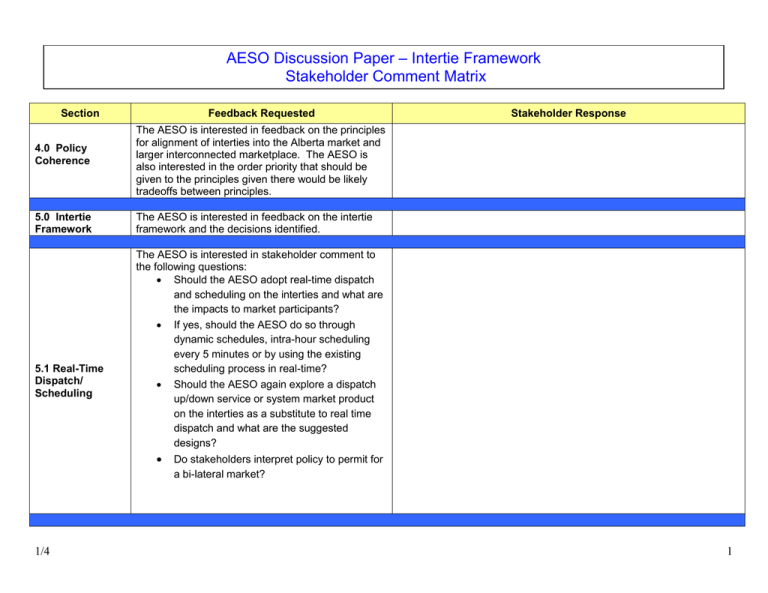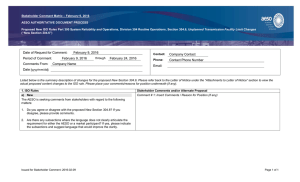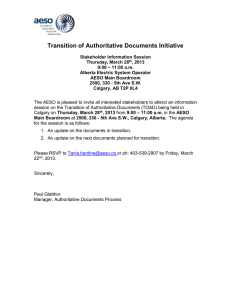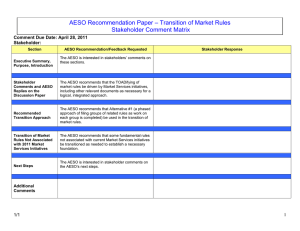– Intertie Framework AESO Discussion Paper Stakeholder Comment Matrix
advertisement

AESO Discussion Paper – Intertie Framework Stakeholder Comment Matrix Section 4.0 Policy Coherence 5.0 Intertie Framework 5.1 Real-Time Dispatch/ Scheduling Feedback Requested The AESO is interested in feedback on the principles for alignment of interties into the Alberta market and larger interconnected marketplace. The AESO is also interested in the order priority that should be given to the principles given there would be likely tradeoffs between principles. The AESO is interested in feedback on the intertie framework and the decisions identified. The AESO is interested in stakeholder comment to the following questions: Should the AESO adopt real-time dispatch and scheduling on the interties and what are the impacts to market participants? If yes, should the AESO do so through dynamic schedules, intra-hour scheduling every 5 minutes or by using the existing scheduling process in real-time? Should the AESO again explore a dispatch up/down service or system market product on the interties as a substitute to real time dispatch and what are the suggested designs? 1/4 Stakeholder Response Do stakeholders interpret policy to permit for a bi-lateral market? 1 5.2 Transmission Rights - Policy 5.3 Product Priority 5.4 ATC Allocation Tiebreaker 2/4 The AESO is interested in stakeholder comment as to whether current policy permits the assignment of transmission rights to ATC and whether interties should be treated by the same rules as internal generators and loads. The AESO is interested to stakeholder comment to the following questions: What would be objectives of a new product on top of an opportunity transmission product to import and export customers? What would be the design options of a new product (see appendix A for assistance)? Should ATC priority be assigned by tariff/commercial product? Would an auction to different products be preferred and what would be the design of that auction methodology? The AESO is interested in stakeholder comment to the following questions: Should the AESO adopt a pro-rata solution instead of LIFO as a tie breaker? If pro-rata is used, how should it be calculated? If LIFO is used, should the AESO use LIFO at xx:yy or only approve up to the system ATC? What time xx:yy should be used in curtailment to maximize utilization of the ATC and provide maximum flexibility to participants and transmission operators? What differences in application may be 2 7.0 Next Steps required for import as opposed to export transactions? What other design options are there for considering ATC allocation tiebreakers? The AESO is interested in stakeholder comment on the AESO’s next steps. The following table can be used as a guide to proposing tariff product design. Please fill out the suggested design detail as per the characteristic. You may suggest new characteristics. I1 I1a I1b I1c I1d I2 I2a I2b I2c I2d I2e I2f I2g 3/4 Characteristic Legislated Requirements Planning Recovery of connection costs Recovery of system costs Losses Currently-Approved Tariff Provisions Bulk system charge Local system charge Point of Delivery (POD) charge Operating reserve charge Loss charges Voltage control (TMR) charge Other system support charge Proposed Product Design 3 I2h I2i I2j I2k I2l I3 I3a I3b I3c I3d I3e I3f I3g 4/4 Characteristic Take or pay provisions Transaction fees Construction contribution/ Interconnection Costs Generator system contribution Contract term Other Considerations Conceptual basis Market access System planned to accommodate Curtailment for capacity limitations Price offers/bids Supply surplus/shortfall conditions Market Obligations Proposed Product Design 4



